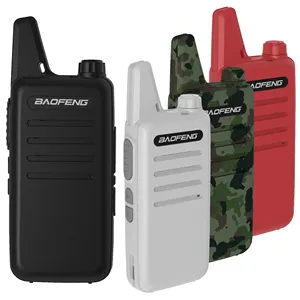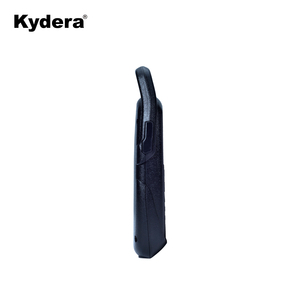(436 products available)


































































































































































































































A walkie talkie with an emergency button is a handheld radio device that enables users to communicate with others on the same frequency. The emergency button can be pressed when the user is in a risky situation and needs immediate help. Walkie talkies are used in industries such as construction, security, and hospitality, as well as for outdoor activities like hiking and camping.
There are different types of walkie talkies, including family radios, business radios, and amateur or ham radios. They work by converting the airwaves' voice signals from an analog to a digital format. They then transmit them through the air to another walkie-talkie, which receives the digital signals and changes them back to analog. Walkie talkies have a specific radiofrequency range that they can operate within. The range depends on the wattage of the walkie-talkie. A higher wattage allows the walkie-talkie to communicate over a longer distance.
There are two types of walkie-talkies, UHF and VHF. UHF walkie-talkies operate at a higher frequency than VHF walkie-talkies. They are more versatile and can be used both indoors and outdoors. UHF walkie-talkies are ideal for businesses with multiple floors or buildings, as they can penetrate through walls and other obstructions. They are also suitable for outdoor use because they can transmit over hilly and mountainous terrain. VHF walkie-talkies are better for outdoor use over long distances. They can transmit further than UHF walkie-talkies if there is a clear line of sight between them.
There are also different types of walkie talkies based on their size and weight. These include handheld walkie-talkies, which are small and lightweight. They can easily fit in the user's hand or pocket. Handheld walkie-talkies are battery-powered, making them portable. There are also vehicle-mounted walkie-talkies that can be attached to a car or other vehicle. These walkie-talkies are powered by the vehicle's battery. Another type of walkie-talkie is the base station walkie-talkie. It is larger than the other types of walkie-talkies. Base station walkie-talkies have a more powerful transmitter, allowing them to communicate over a longer distance. They are usually mounted on a desk or table.
The walkie-talkie with an emergency button is a versatile communication tool designed to facilitate quick and easy communication in various situations. The following are important functions and features of walkie talkie with emergency button:
The key feature of the walkie talkie with an emergency button is the emergency alert feature. It allows the user to send out a distress signal to the intended receiver or the entire team. The emergency button is usually large and prominently placed on the radio for easy access in critical situations. When the button is pressed, the radio typically emits a loud alarm or tone, indicating that an emergency alert has been activated. Some walkie talkies with emergency buttons may also automatically switch to a preprogrammed emergency channel and transmit the distress signal. The emergency alert feature is particularly useful in hazardous environments, outdoor activities, or any situation where immediate assistance may be required.
Many walkie talkies with emergency buttons are designed to withstand harsh conditions. They are usually built with robust materials that can withstand impact. Some models have an IP (Ingress Protection) rating, which demonstrates their ability to resist water and dust. Walkie talkies with emergency buttons can be used in harsh environments without malfunctioning.
Many walkie talkies with emergency buttons have a long battery life. They are usually powered by rechargeable batteries. Walkie talkies with emergency buttons usually come with a charging dock for easy charging. Some models allow the user to switch to AA or AAA batteries when the rechargeable batteries run out of power. A long battery life ensures that the radio remains functional when needed most.
Many walkie talkies with emergency buttons support different frequency ranges. Walkie talkies with emergency buttons usually have a frequency range of 136-174 MHz or 400-520 MHz. They may operate on very high frequency (VHF) or ultra-high frequency (UHF). VHF frequencies enable the radio waves to travel further when there are no obstructions. UHF frequencies are ideal for use in urban areas and indoors. Some walkie talkies with emergency buttons operate on a single designated frequency, while others have multiple channels.
Many walkie talkies with emergency buttons have a range of up to 20 miles. However, it is important to note that the actual range may be affected by obstructions, weather conditions, and the surrounding terrain. In most cases, the radio waves can only travel in a straight line. The range is shorter in hilly areas because the signal can't go through the hills. Range is also affected by buildings and trees. Walkie talkies with emergency buttons are usually designed for use in line-of-sight situations. A higher wattage generally results in a longer range.
Many walkie talkies with emergency buttons have a VOX (Voice-Activated Transmit) function. A walkie talkie with an emergency button and VOX allows the user to communicate without pressing the Push-to-Talk button. The radio will begin transmitting when it detects the user speaking. The VOX sensitivity can usually be adjusted to accommodate different noise levels. Many walkie talkies with emergency buttons have three or four sensitivity levels.
Walkie talkies with an emergency button are essential communication tools that can be used in various scenarios. They are used in businesses, industries, and organizations to ensure reliable and instant communication. Here are some of the scenarios in which walkie talkies with emergency buttons can be used:
When buying a walkie talkie with an emergency button, buyers must consider specific criteria to ensure they meet user needs. The following tips and considerations help buyers make an informed purchasing decision.
Buyers must understand the user's needs before purchasing a walkie talkie with an emergency button. Knowing the user's location, surrounding environment, and communication range will help buyers choose the right device. For instance, a survival walkie talkie with an emergency button might be suitable for users in remote areas, while a business walkie talkie might be ideal for hotel staff.
Buyers should consider the communication range and frequency of the walkie talkie. The communication range should cover the user's distance, while VHF or UHF frequency is better for outdoor use, and UHF is ideal for indoor use.
Buyers should choose a walkie talkie with a long battery life to ensure continuous communication in case of an emergency. Some models use rechargeable batteries and can be charged in a car or solar power.
If the walkie talkie is intended for outdoor use, buyers should choose a weather-resistant model. Look for an IPX rating, as it shows how well the walkie talkie can resist water and dust.
Consider a walkie talkie with a duplex feature for simultaneous two-way communication. This feature allows users to talk and listen at the same time, just like a phone call.
Choose a reputable brand that offers a variety of models, such as Retevis, Motorola, and Baofeng. Each brand has its pros and cons. For instance, a Motorola walkie talkie with an emergency button is durable and reliable, while Baofeng is affordable. Buyers can check reviews to get an idea of the brand's reputation.
Buyers should choose a walkie talkie with an emergency button that fits their budget. Consider the cost of accessories, such as a charger, before purchasing a rechargeable model. Also, keep in mind that a higher price doesn't always mean better quality.
Walkie talkies with emergency buttons may require a license to operate, depending on the frequency and power output. Know the local laws and regulations before purchasing a walkie talkie that requires a license. Buyers can get in touch with the supplier to learn more about the licensing requirements.
Q1. What are the benefits of walkie-talkies with emergency buttons?
A1. Walkie-talkies with emergency buttons are crucial for communication. They can provide an effective means of communication during emergencies. Walkie-talkies with emergency buttons are versatile tools that can be used in various industries, from construction to security. They can also be used for outdoor activities and adventure travel.
Q2. How should a walkie-talkie with an emergency button be maintained?
A2. To ensure optimal performance, regular maintenance of walkie-talkies is essential. This involves inspecting the devices for physical damage or wear, ensuring that all buttons work correctly, and checking for any software updates. Also, it is important to keep walkie-talkies clean by removing dust and debris from the exterior surfaces. In addition, it is important to store walkie-talkies in a safe, dry place when they are not in use. To prevent battery drain, it is important to remove or recharge the batteries if the walkie-talkies will be stored for an extended period.
Q3. What factors to consider when choosing walkie-talkies with emergency buttons?
A3. When choosing walkie-talkies with emergency buttons, buyers should consider factors such as range, frequency, and durability. It is also important to consider the industry or application for which the walkie-talkies will be used. For example, construction walkie-talkies may have different features than those used for outdoor recreation.
Q4. How to use the emergency button on a walkie-talkie?
A4. To use the emergency button on a walkie-talkie, the user must press and hold the button for a few seconds. After activating the emergency signal, the walkie-talkie will transmit the pre-programmed alert tone and message on the designated frequency or channel.